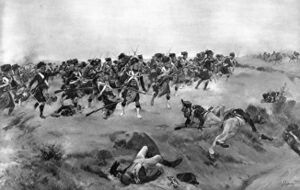Battle of Kingston Heights
| Battle of Kingston Heights | |||||||
|---|---|---|---|---|---|---|---|
| Part of the Concordian Civil War | |||||||
 Rubrumian Militia attacking Republican positions at the base of the heights | |||||||
| |||||||
| Belligerents | |||||||
| Commanders and leaders | |||||||
| Units involved | |||||||
| Strength | |||||||
| 2,500 regulars and militia | 5,750 regulars and militia | ||||||
| Casualties and losses | |||||||
|
74 dead 159 wounded |
579 dead 401 wounded | ||||||
The Battle of Kingston Heights (27 April 1863- 1 May 1863) was a battle that took place in Upper Rubrum. Republican forces were to take Kingston Heights in order to capture York (present-day Toronto) and culminate in an invasion of Concordia from the north. Had the Republicans succeeded, the Lucis Intervention wouldn't have been possible to intervene and engage the Republicans on Rubrumian soil.
The battle occurred after the Battle of Saint Laurence. During this time, General Sibley and du Champs were still unaware that the Republican and Federal Navies were destroyed and that intervention forces began to land in Lower Rubrum near Montreal until 10 days later. Only defended by a handful of regulars and militia forces, the Rubrumians were outnumbered. Despite their overwhelming numbers, the Republicans failed to attack on the intended date which was set on the 25th of April. The reason was to await for the arrival of the Federal forces under Marshal Kristain du Champs, which granted the Rubrumians more time to prepare. By the time the battle took place, Rubrumian Artillery began bombarding Republican positions, causing widespread panic among the Republicans. The attack continued until 1 May.
After the battle, the Republicans were on the defensive and started losing ground all the way to Quebecois City. It would take six more days before the Republicans would find out that they have been isolated due to the blockade by the Royal Navy on the Gulf of Saint Laurence.
Prelude
Preparations
Republican Army
The Republican Army during the battle was led by General Liam Connor Sibley. About 3,000 men strong, Sibley bought with him the most elite formation in the Concordian Republican Army, which was the Republican Guards that numbered to 900 men, roughly 30% of the Concordians who participated in the battle. Sibley separated from the main force led by General Ambrose T. Colston (who was later killed during the Battle of Quebecois City in the Autumn of 1863) having been ordered to move ahead of the main force and clear any form of enemy resistance to the road leading to York.
They were also professionally trained, more so than the Rubrumian Militia. Both trained for offensive and defence, the men under Sibley's command had seen action since the First Battle of Manassas. Praised by Archadian Marshal Henrico Eltore, the Republican troops had a reputation similar to those of the elite regiments rather than a regular regiment.
Order of Battle: Sibley's Detachment, Infantry
- 5th Republican Guards Regiment, Concordian Republican Guards Corps
- 70th (3rd Selkirk Highlanders) Georgia Infantry Regiment, Selkirk Highlanders
- 26th North Carolina Infantry Regiment
- 14th Texas Infantry Regiment
- 16th Mississippi Infantry Regiment
- 1st Battalion, Coffeeville Rifles
- 2nd Battalion, CoffeeVille Rifles
- 1st Mississippi Marine Regiment, Concordian Republican Marine Corps
- Hood's Battery, 3rd North Carolina Artillery
- MacKrycul's Battery, 4th Georgia Artillery
Federal Army
The Atlantic Federal Army was led by Marshal Kristain du Champs. In the Federation, he has a reputation for soundly routing the East Imperial Army during the War of 1840. When the Federation decided to retake its former colony of Quebecois, High Premier Francois Mouland sent du Champs to Quebecois while his counterpart, General Jean Weyland was assigned to support the Concordian Republican Army in pushing further to Maryland.
The Federal Army under du Champs were overall trained and fit for all kinds of roles. About 2,750 Federal troops fought in the battle and supported the Republican troops eagerly. However, the Federation had no interest in waging a campaign to Upper Rubrum and many were delegated to the Quebecois Front, where it fought against some locals loyal to the Lucian Crown. They also had the Premier's Federal Guards, which was the main elite force of the Federal Army and proved to be as elite as the Concordian's Republican Guards
Rubrumian Defence Force
The Rubrumian Defence Force on the eve of the battle was led by Brigadier Tanahashi Susaya. Of the Rubrumian forces in Kingston Heights, 60% of it constituted militia formations and slightly lacked training. Infantry quality was inferior to the Republicans and Federals. Only 40% would account for a regular army force. About 2,000 troops were available during the battle and 500 in reserve. However, Susaya and his forces had terrain knowledge. Susaya was aware that the Republican Forces were planning to take York and use it to invade Northern Concordia. During April, the ground was slightly muddy around the heights and Susaya decided that the best place to defend York was in Kingston Heights.
Strong fortifications were built around the heights. Rubrumian Artillery were positioned behind the heights near the road to York. In the case of a retreat, Susaya had the 500 reserve infantry to act as a rear guard in case the Republicans attacked with overwhelming numbers. The Rubrumians also had a wide range of armaments, including the famed Mk. II Gatling Gun, which proved invaluable to the defence on the heights.
On May 1, reinforcements in the form of the elite Black Watch arrived and would later cause devastating casualties during the final hours of the battle.
